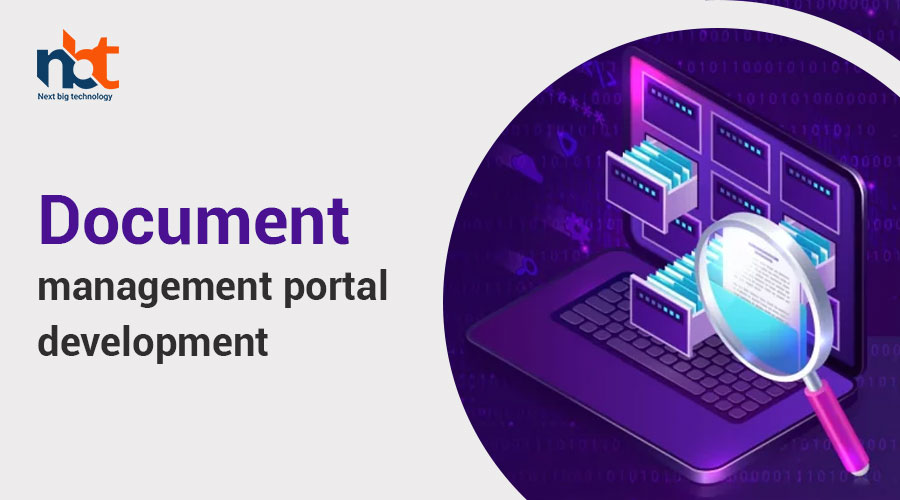Table of Contents
Document management portal development Services
In the digital age, managing documents efficiently is crucial for businesses of all sizes. Document management portal development services offer a comprehensive solution to streamline document handling, storage, retrieval, and collaboration. These services empower organizations to optimize their workflow, enhance productivity, and ensure compliance with regulatory requirements.
Document management portal development involves the creation of a centralized platform where users can securely store, organize, and access documents from anywhere, at any time. These portals are tailored to meet the specific needs of each organization, incorporating features such as version control, access controls, audit trails, and integration with existing systems.
One of the primary benefits of document management portal development services is the elimination of paper-based processes. By digitizing documents and automating workflows, businesses can reduce the risk of errors, improve accuracy, and save valuable time and resources. Employees no longer need to waste time searching for paper documents or waiting for approvals, as everything is accessible at their fingertips.
Furthermore, document management portals facilitate seamless collaboration among team members, regardless of their location. Users can securely share documents, collaborate on projects, and track changes in real-time, fostering greater transparency and efficiency. This level of collaboration not only accelerates decision-making but also promotes innovation and creativity within the organization.
Another advantage of document management portal development services is enhanced security. These portals utilize advanced encryption and access controls to protect sensitive information from unauthorized access or breaches. Additionally, audit trails and activity logs enable administrators to monitor user activity and ensure compliance with data protection regulations.
In today’s fast-paced business environment, having instant access to accurate information is essential for making informed decisions. Document management portals enable organizations to retrieve documents quickly and easily, eliminating delays and improving responsiveness to customer inquiries or regulatory requests. This accessibility also fosters a culture of knowledge sharing and continuous improvement within the organization.
Moreover, document management portal development services are scalable and customizable, allowing businesses to adapt to changing needs and growth opportunities. Whether you’re a small startup or a large enterprise, these services can be tailored to fit your unique requirements and budget constraints. From document scanning and digitization to workflow automation and integration with third-party applications, the possibilities are endless.
How to Create a Document management portal development
In today’s digital age, managing documents efficiently is crucial for businesses to streamline their operations and boost productivity. A document management portal serves as a centralized platform to store, organize, and retrieve documents securely. Building such a portal requires careful planning and execution to ensure it meets the specific needs of your organization. In this guide, we’ll walk you through the essential steps to create a robust document management portal development:
- Define Objectives and Requirements: Begin by identifying the objectives of your document management portal. Determine what types of documents you need to manage, who will access them, and what functionalities are necessary. Understanding your requirements will guide the development process effectively.
- Choose the Right Technology Stack: Selecting the appropriate technology stack is crucial for the success of your portal. Consider factors such as scalability, security, and integration capabilities. Popular choices for document management portals include cloud-based solutions, open-source platforms, and custom-built systems.
- Design User-Friendly Interface: User experience is paramount when designing a document management portal. Create an intuitive interface that allows users to easily upload, search, and retrieve documents. Incorporate features such as categorization, tagging, and version control to enhance usability.
- Implement Security Measures: Protecting sensitive documents from unauthorized access is paramount. Implement robust security measures such as user authentication, role-based access control, encryption, and audit trails to ensure the confidentiality and integrity of your data.
- Integrate with Existing Systems: Your document management portal should seamlessly integrate with other software systems used within your organization, such as CRM, ERP, and collaboration tools. This integration streamlines workflows and enhances productivity by eliminating duplicate data entry and facilitating information sharing.
- Provide Collaboration Features: Foster collaboration among team members by incorporating features such as real-time document editing, comments, and notifications. This promotes teamwork and facilitates efficient document collaboration, even among remote teams.
- Ensure Compliance with Regulations: Depending on your industry and location, there may be regulatory requirements governing document management. Ensure your portal complies with relevant regulations such as GDPR, HIPAA, or industry-specific standards to avoid legal issues and protect sensitive information.
- Perform Testing and Quality Assurance: Thoroughly test your document management portal before deployment to identify and address any bugs or issues. Conduct usability testing to gather feedback from end-users and make necessary improvements to enhance the overall user experience.
- Train Users and Provide Support: Train your team members on how to use the document management portal effectively. Provide comprehensive documentation, tutorials, and ongoing support to address any questions or issues that may arise post-deployment.
- Monitor Performance and Continuously Improve: Monitor the performance of your document management portal regularly and gather feedback from users to identify areas for improvement. Continuously update and enhance the portal to adapt to evolving business needs and technology advancements.
Why Should You Go for Document management portal development
In today’s fast-paced digital world, managing documents efficiently is crucial for the success and growth of any business. With the advent of technology, traditional paper-based document management systems are becoming obsolete, giving way to more advanced and sophisticated solutions like document management portals. These portals offer a wide range of benefits that can streamline your document management processes and boost productivity across your organization. Let’s delve into why you should consider investing in document management portal development.
- Centralized Document Repository: One of the primary advantages of document management portals is that they provide a centralized repository for all your documents. Instead of scattering documents across various folders, cabinets, or email inboxes, you can store them securely in one location accessible to authorized users. This ensures easy access to information whenever needed, eliminating the hassle of searching through multiple sources.
- Improved Accessibility and Collaboration: Document management portals enable seamless access to documents from anywhere, at any time, as long as there is an internet connection. This feature is particularly beneficial for businesses with remote or distributed teams. Additionally, these portals facilitate collaborative work by allowing multiple users to view, edit, and comment on documents simultaneously, fostering better teamwork and faster decision-making processes.
- Enhanced Security: Security is a top priority for businesses when it comes to document management. Document management portals offer robust security features such as encryption, access controls, and audit trails to protect sensitive information from unauthorized access, breaches, or data loss. With these measures in place, you can have peace of mind knowing that your documents are safe and compliant with regulatory requirements.
- Streamlined Workflow Automation: Manual document management processes are not only time-consuming but also prone to errors. Document management portals come equipped with workflow automation capabilities that help streamline repetitive tasks, such as document routing, approvals, and notifications. By automating these processes, you can save valuable time and resources, allowing your employees to focus on more strategic initiatives.
- Scalability and Customization: Whether you’re a small startup or a large enterprise, document management portals are scalable to accommodate your growing needs. You can easily add or remove users, expand storage capacity, or integrate additional features as your business evolves. Furthermore, these portals can be customized to align with your specific workflows, business rules, and branding preferences, ensuring a tailored solution that fits your unique requirements.
- Cost Savings: Investing in document management portal development may seem like an additional expense initially, but it can result in significant cost savings in the long run. By eliminating paper-based processes, reducing manual labor, and minimizing the risk of compliance violations or legal issues, you can optimize operational efficiency and lower overhead costs associated with document management.
Market Prospects of Document management portal development and Platforms
In today’s digital age, the significance of efficient document management cannot be overstated. With businesses striving to streamline their operations, enhance productivity, and maintain regulatory compliance, the demand for robust document management solutions is on the rise. Document management portal development and platforms offer a comprehensive solution to organize, store, and access documents securely. In this article, we delve into the market prospects of document management portal development and platforms, highlighting key trends, challenges, and opportunities.
- Rising Demand for Digital Transformation: The increasing adoption of digital transformation across industries is a primary driver for the growth of document management portal development and platforms. Businesses are transitioning from traditional paper-based document processes to digital solutions to improve efficiency, collaboration, and accessibility.
- Remote Workforce Dynamics: The global shift towards remote work arrangements has fueled the need for cloud-based document management solutions. Document management portals enable remote employees to access, edit, and share documents seamlessly, regardless of their location. This trend is expected to drive the market growth significantly in the coming years.
- Focus on Compliance and Security: Heightened concerns regarding data security and regulatory compliance have propelled organizations to invest in robust document management systems. Document management portals offer features such as encryption, access controls, audit trails, and compliance monitoring, thereby ensuring data integrity and confidentiality.
- Integration with AI and Machine Learning: The integration of artificial intelligence (AI) and machine learning (ML) technologies into document management portals is revolutionizing document management processes. Advanced features such as automatic categorization, intelligent search, and predictive analytics enhance efficiency and decision-making, further driving the demand for these platforms.
- Emergence of Industry-specific Solutions: With diverse industry requirements, there is a growing trend towards the development of industry-specific document management solutions. Whether it’s healthcare, finance, legal, or manufacturing, tailored document management portals cater to unique industry needs, offering specialized features and compliance standards.
- SMEs Embracing Document Management Solutions: Small and medium-sized enterprises (SMEs) are increasingly recognizing the benefits of document management portals in optimizing their operations and reducing costs. As the accessibility and affordability of these solutions improve, SMEs are expected to contribute significantly to the market growth.
Challenges:
- Data Privacy Concerns: Despite advancements in security measures, concerns regarding data privacy and compliance remain a challenge for document management portal development. Ensuring strict adherence to regulations such as GDPR and HIPAA requires continuous efforts and investment in security protocols.
- Integration Complexities: Integrating document management portals with existing enterprise systems and workflows can pose challenges, particularly for large organizations with complex IT infrastructures. Seamless integration is crucial to maximize the effectiveness and adoption of these platforms.
- User Adoption and Training: Successful implementation of document management portals depends on user adoption and proficiency. Organizations need to invest in comprehensive training programs and user-friendly interfaces to facilitate smooth adoption and utilization across all levels of the workforce.
Opportunities:
- Expanding Market Reach: The global reach of document management portal development presents vast opportunities for expansion. Emerging markets, especially in Asia-Pacific and Latin America, offer untapped potential for vendors to introduce innovative solutions tailored to regional needs.
- Focus on Sustainability: With increasing environmental awareness, there is a growing demand for sustainable document management practices. Eco-friendly features such as paperless workflows, energy-efficient data centers, and carbon footprint reduction initiatives present opportunities for differentiation and market leadership.
- Innovations in Mobile Accessibility: The proliferation of mobile devices has created opportunities for document management portal developers to enhance mobile accessibility and functionality. Mobile-friendly interfaces, offline access, and cross-platform compatibility are key areas for innovation to cater to the mobile workforce effectively.
Essential Features of a Document management portal development
In today’s digital age, managing documents efficiently is crucial for businesses to streamline operations, enhance productivity, and ensure compliance. Document management portals serve as centralized platforms to store, organize, and access documents securely. However, developing an effective document management portal requires careful consideration of essential features to meet the diverse needs of users. Let’s explore some key features that are fundamental for a robust document management portal development.
- User Authentication and Access Control: Implementing robust user authentication mechanisms such as multi-factor authentication (MFA) and role-based access control (RBAC) ensures that only authorized users can access sensitive documents. This feature enhances security and prevents unauthorized access to confidential information.
- Document Capture and Indexing: An efficient document management portal should support various methods of document capture, including scanning, uploading, and automated data extraction. Additionally, incorporating intelligent indexing techniques such as optical character recognition (OCR) facilitates easy searching and retrieval of documents based on keywords or metadata.
- Version Control and Audit Trails: Version control functionality enables users to track changes made to documents over time, ensuring accountability and transparency. Audit trails provide detailed logs of user activities within the portal, including document views, edits, and downloads, which are essential for compliance purposes.
- Document Collaboration and Workflow Automation: Enabling real-time collaboration features such as document sharing, commenting, and task assignments enhances team productivity and facilitates seamless collaboration across departments. Integration with workflow automation tools allows businesses to automate repetitive tasks and streamline document approval processes, improving operational efficiency.
- Security and Encryption: Robust encryption protocols and data security measures are essential to safeguard sensitive documents from unauthorized access, data breaches, and cyber threats. Implementing end-to-end encryption ensures that documents remain secure both in transit and at rest within the document management portal.
- Integration with Third-Party Applications: Seamless integration with existing business applications such as customer relationship management (CRM) systems, enterprise resource planning (ERP) software, and cloud storage platforms enhances interoperability and data accessibility. This integration streamlines workflows and eliminates the need for manual data entry and duplicate document storage.
- Scalability and Performance: A scalable architecture capable of handling large volumes of documents and users is essential for accommodating future growth and expansion. Optimizing performance through caching mechanisms, load balancing, and database optimization ensures responsive user experience even during peak usage periods.
- Compliance and Regulatory Standards: Adhering to industry-specific compliance regulations such as GDPR, HIPAA, and SOC 2 is imperative for businesses dealing with sensitive or regulated data. Implementing features such as data retention policies, access controls, and document encryption helps ensure compliance with relevant regulatory standards.
- Customization and Branding: Providing options for customization and branding allows organizations to tailor the document management portal to align with their brand identity and user preferences. Customizable user interfaces, branding elements, and workflow configurations enhance user adoption and engagement.
- Analytics and Reporting: Incorporating analytics and reporting tools enables organizations to gain insights into document usage patterns, user behavior, and system performance. Generating customizable reports and dashboards helps stakeholders make informed decisions, identify areas for improvement, and track compliance metrics.
Advanced Features Document management portal development
In today’s digital age, the ability to manage documents efficiently is paramount for businesses striving for success. Document management portals have become indispensable tools, offering centralized repositories for storing, organizing, and accessing crucial information. However, to stay ahead in the competitive landscape, businesses must leverage advanced features in their document management portals. These features not only enhance productivity but also streamline workflows and ensure compliance with regulatory standards.
- Intelligent Search Functionality: Incorporating advanced search algorithms enables users to quickly locate documents based on keywords, metadata, or even content within the document. Integration with natural language processing (NLP) technology further enhances search capabilities, allowing for more intuitive and accurate results. By empowering users to find relevant information swiftly, businesses can boost productivity and decision-making processes.
- Version Control and Document History: Implementing version control features ensures that users always have access to the most up-to-date version of a document. Document history functionality provides insights into changes made over time, including edits, revisions, and approvals. This not only improves collaboration but also enhances transparency and accountability within the organization.
- Role-Based Access Control: Customizable access control mechanisms based on roles and permissions allow administrators to regulate who can view, edit, or delete specific documents. By enforcing granular access control, businesses can safeguard sensitive information and comply with data privacy regulations such as GDPR and HIPAA. Additionally, role-based access control enhances security by minimizing the risk of unauthorized access.
- Workflow Automation: Integration of workflow automation tools streamlines document-centric processes, such as approvals, reviews, and notifications. By automating repetitive tasks, businesses can reduce manual intervention, minimize errors, and accelerate time-to-market. Advanced workflow capabilities enable the creation of custom workflows tailored to the organization’s unique requirements, enhancing efficiency and agility.
- Document Collaboration and Annotation: Real-time collaboration features facilitate seamless communication and collaboration among team members, regardless of geographical locations. Users can co-author documents, share feedback, and track changes in a collaborative environment. Furthermore, annotation tools enable users to add comments, annotations, and markups directly within the document, fostering collaboration and improving document comprehension.
- Integration with Third-Party Applications: Seamless integration with other business applications such as CRM, ERP, and project management tools enhances interoperability and data exchange. By breaking down silos and facilitating data synchronization, businesses can streamline processes and improve cross-functional collaboration. Integration with cloud storage providers also enables seamless access to documents from any device, anywhere, and at any time.
- Analytics and Reporting: Advanced analytics capabilities provide valuable insights into document usage, access patterns, and user behavior. By leveraging analytics and reporting tools, businesses can identify trends, optimize processes, and make data-driven decisions. Furthermore, compliance reporting features facilitate auditing and regulatory compliance, ensuring adherence to industry standards and regulations.
Document management portal development Timelines
In today’s fast-paced digital era, businesses are constantly seeking ways to streamline their operations and improve efficiency. One crucial aspect of this endeavor is managing documents effectively. Document management portals play a pivotal role in facilitating seamless document organization, collaboration, and accessibility. However, developing a robust document management portal requires careful planning and adherence to timelines to ensure successful implementation. In this article, we’ll delve into the key factors involved in the timeline of document management portal development.
- Initial Planning and Requirements Gathering: Before diving into development, it’s essential to conduct thorough planning and gather requirements. This phase involves defining the objectives of the document management portal, identifying user needs, and outlining specific features and functionalities. Depending on the complexity of the project, this stage can take anywhere from a few days to a couple of weeks.
- Design and Prototyping: Once the requirements are clear, the next step is to design the user interface (UI) and create prototypes of the portal. This phase focuses on creating a visually appealing and user-friendly interface that aligns with the client’s branding and preferences. Design and prototyping typically take around 2-3 weeks, during which feedback from stakeholders is crucial for refinement.
- Development and Testing: The development phase involves coding the backend infrastructure, implementing frontend designs, and integrating necessary features such as document uploading, version control, access control, and search functionality. Simultaneously, rigorous testing is conducted to identify and rectify any bugs or issues. Depending on the complexity of the portal, this phase can take anywhere from 4-8 weeks.
- Deployment and User Training: Once development and testing are complete, the document management portal is ready for deployment. This involves deploying the portal to the production environment, configuring settings, and ensuring seamless integration with existing systems. Additionally, providing comprehensive training to users on how to navigate the portal and utilize its features effectively is crucial for successful adoption. Deployment and user training typically take around 1-2 weeks.
- Post-Deployment Support and Maintenance: Even after the portal is live, ongoing support and maintenance are essential to ensure optimal performance and address any issues that may arise. This includes monitoring system health, applying updates and patches, and providing technical assistance to users as needed. Post-deployment support and maintenance are ongoing processes that continue throughout the lifecycle of the document management portal.
It’s important to note that the timeline for document management portal development can vary depending on various factors such as the complexity of the project, the availability of resources, and unforeseen challenges encountered during the process. However, by following a structured approach and adhering to timelines diligently, businesses can successfully develop and deploy a robust document management portal that enhances productivity, collaboration, and data security.
How Much Does It Cost to Build a Document management portal development?
In today’s digital age, the importance of efficient document management cannot be overstated. As businesses strive to streamline their operations and enhance productivity, investing in a robust document management portal has become essential. However, one common question that arises is, “How much does it cost to build a document management portal?” Let’s delve into this topic to gain a better understanding of the factors influencing the costs involved.
- Scope and Complexity: The first aspect to consider is the scope and complexity of the document management portal. Do you need a basic system for organizing and storing documents, or do you require advanced features such as version control, workflow automation, and advanced search functionalities? The complexity of your requirements will significantly impact the overall cost.
- Features and Functionality: The features you want to incorporate into your document management portal will directly affect the development costs. Basic features like document uploading, categorization, and user access control will be more affordable compared to advanced features such as optical character recognition (OCR), document collaboration, and integration with third-party applications.
- User Interface (UI) and User Experience (UX): A user-friendly interface is crucial for ensuring widespread adoption and efficient usage of the document management portal. Investing in intuitive UI/UX design will enhance user satisfaction but may add to the development costs. Customization options, branding elements, and responsive design for multiple devices should also be taken into account.
- Security Measures: Security is paramount when it comes to managing sensitive documents. Implementing robust security measures, including encryption, access controls, audit trails, and regular security updates, will incur additional costs. However, it’s essential to prioritize security to protect sensitive information from unauthorized access or data breaches.
- Integration Requirements: Consider whether you need to integrate the document management portal with existing systems or third-party applications such as CRM software, ERP systems, or cloud storage services. Seamless integration will enhance productivity and efficiency but may require additional development efforts and incur extra costs.
- Scalability and Future Growth: A scalable document management portal should be able to accommodate future growth and evolving business needs. Investing in a scalable architecture upfront may increase initial costs but will save money in the long run by avoiding the need for significant redesign or redevelopment as your business expands.
- Development Approach and Technology Stack: The development approach (e.g., custom development vs. using pre-built solutions) and the choice of technology stack (programming languages, frameworks, databases, etc.) will influence development costs. Consider factors such as maintenance, support, and scalability when selecting the technology stack.
- Testing and Quality Assurance: Thorough testing and quality assurance are essential to ensure the reliability, performance, and security of the document management portal. Budget for testing activities such as functional testing, performance testing, security testing, and user acceptance testing to deliver a high-quality product.
How to Create a Document management portal development – Team and Tech Stack
In today’s digital age, effective document management is crucial for businesses to streamline operations, enhance productivity, and ensure compliance. Developing a document management portal tailored to your organization’s needs requires careful planning, a skilled team, and the right technological foundation. In this guide, we’ll walk you through the steps to create a robust document management portal, focusing on assembling the right team and selecting an appropriate tech stack.
- Understanding Your Requirements: Before diving into development, it’s essential to define your requirements clearly. Consider factors such as the volume and types of documents you’ll be managing, user roles and permissions, integration with existing systems, compliance regulations, and scalability needs. This understanding will guide your team in building a solution that meets your specific needs.
- Building Your Team: Developing a document management portal requires a multidisciplinary team with expertise in various areas. Your team may include:
- Project Manager: Responsible for overseeing the development process, coordinating tasks, managing timelines, and ensuring effective communication among team members.
- Developers: Front-end and back-end developers skilled in web development frameworks such as React.js, Angular, or Vue.js for the user interface, and Node.js, Django, or Laravel for the backend.
- UX/UI Designers: Designers who focus on creating an intuitive and user-friendly interface for seamless navigation and efficient document management.
- Database Administrators: Experts in database management systems like MySQL, PostgreSQL, or MongoDB, responsible for designing and optimizing the database schema for storing and retrieving documents efficiently.
- Security Experts: Professionals well-versed in cybersecurity practices to implement robust security measures, including access controls, encryption, and data protection, to safeguard sensitive documents from unauthorized access or breaches.
- Selecting the Tech Stack: Choosing the right technology stack is crucial for the success of your document management portal. Consider the following components:
- Front-end Framework: Select a modern JavaScript framework like React.js, Angular, or Vue.js for building a responsive and interactive user interface.
- Back-end Framework: Choose a backend framework that aligns with your team’s expertise and project requirements. Options include Node.js with Express.js, Django with Python, or Laravel with PHP.
- Database: Opt for a reliable and scalable database management system suitable for handling document storage and retrieval. SQL databases like MySQL or PostgreSQL are commonly used for structured data, while NoSQL databases like MongoDB offer flexibility for unstructured data.
- Cloud Services: Consider leveraging cloud services such as Amazon Web Services (AWS), Microsoft Azure, or Google Cloud Platform (GCP) for hosting, storage, and scalability.
- Integration Tools: Implement integration tools or APIs to seamlessly connect your document management portal with other business systems such as CRM, ERP, or accounting software.
- Agile Development Process: Adopt an agile development methodology to iteratively build and refine your document management portal. Break down the project into smaller tasks or user stories, prioritize them based on business value, and continuously gather feedback from stakeholders to ensure alignment with their needs.
- Testing and Quality Assurance: Prioritize testing and quality assurance throughout the development process to identify and address any issues or bugs promptly. Conduct thorough testing, including functional testing, performance testing, security testing, and user acceptance testing, to ensure a reliable and secure document management portal.
- Deployment and Maintenance: Once development and testing are complete, deploy your document management portal to production environment following best practices for deployment automation, monitoring, and ongoing maintenance. Regularly update and enhance your portal based on user feedback, technological advancements, and changing business requirements to ensure its continued effectiveness and relevance.
Document management portal development Process
In today’s fast-paced digital world, businesses are constantly seeking innovative solutions to streamline their operations and enhance productivity. One such solution that has gained significant traction is the development of document management portals. These portals serve as centralized platforms for organizing, storing, and accessing documents securely. In this article, we’ll delve into the process of developing a document management portal and how it can benefit businesses of all sizes.
- Understanding the Requirements: The first step in the development process is to understand the specific requirements of the business. This involves identifying the types of documents that need to be managed, the desired features and functionalities of the portal, and any compliance or security considerations.
- Design and Planning: Once the requirements are clear, the next step is to design the architecture of the document management portal. This involves creating a user-friendly interface, defining access control mechanisms, and mapping out the workflow for document storage and retrieval.
- Development and Integration: With the design in place, the development team can start building the portal. This typically involves writing code, integrating third-party tools or services, and ensuring compatibility with existing systems such as customer relationship management (CRM) or enterprise resource planning (ERP) software.
- Testing and Quality Assurance: Before the portal is rolled out to users, rigorous testing is conducted to identify and fix any bugs or issues. This includes functional testing to ensure all features work as intended, as well as security testing to identify and mitigate potential vulnerabilities.
- Deployment and Training: Once the portal has been thoroughly tested and approved, it can be deployed for use within the organization. It’s essential to provide comprehensive training to users to ensure they understand how to effectively utilize the portal and maximize its benefits.
- Ongoing Maintenance and Support: The development process doesn’t end with deployment – ongoing maintenance and support are critical to ensuring the portal remains functional and up-to-date. This involves monitoring performance, applying software updates, and addressing any user feedback or issues that arise.
By implementing a document management portal, businesses can reap a multitude of benefits. Firstly, it improves efficiency by streamlining document storage and retrieval processes, reducing the time and effort required to find information. Secondly, it enhances collaboration by enabling multiple users to access and work on documents simultaneously, regardless of their location. Thirdly, it enhances security by implementing robust access control mechanisms and encryption protocols to protect sensitive information from unauthorized access or data breaches.
Next Big Technology – Your Trusted Document management portal development Partner
In the contemporary digital landscape, the efficient management of documents plays a pivotal role in the success of businesses across various industries. As organizations continue to embrace digital transformation, the demand for reliable document management solutions is at an all-time high. In this context, selecting the right technology partner becomes crucial to ensure seamless operations and optimal utilization of resources. Enter the Next Big Technology – your trusted document management portal development partner.
With a relentless commitment to innovation and a proven track record of delivering cutting-edge solutions, Next Big Technology stands out as a leader in the realm of document management. Here’s why partnering with us can propel your business to new heights:
- Tailored Solutions: At Next Big Technology, we understand that one size does not fit all when it comes to document management. Our team of experienced developers works closely with clients to understand their unique requirements and tailor solutions that align perfectly with their business objectives. Whether you need a cloud-based document repository, workflow automation, or advanced security features, we’ve got you covered.
- User-Centric Design: We believe that user experience is paramount in driving adoption and maximizing the value of document management systems. That’s why we place a strong emphasis on intuitive design and usability, ensuring that your employees can easily navigate the platform and perform their tasks efficiently. From seamless onboarding to ongoing support, we’re committed to delivering an exceptional user experience at every touchpoint.
- Scalability and Flexibility: As your business evolves and grows, so do your document management needs. Our solutions are built with scalability and flexibility in mind, allowing you to adapt to changing requirements and scale up seamlessly as your organization expands. Whether you’re a small startup or a multinational corporation, our document management portal can grow with you every step of the way.
- Robust Security Measures: We understand the critical importance of data security in today’s digital landscape. That’s why we employ the latest encryption techniques and security protocols to ensure that your sensitive documents are protected at all times. With Next Big Technology as your partner, you can have peace of mind knowing that your confidential information is in safe hands.
- Continuous Innovation: In a fast-paced technological landscape, staying ahead of the curve is essential for maintaining a competitive edge. At Next Big Technology, we are committed to continuous innovation, constantly exploring new technologies and methodologies to enhance our document management solutions. By partnering with us, you can rest assured that you’ll always have access to the latest advancements in the field.
Enterprise Document management portal development
In today’s fast-paced digital landscape, managing documents efficiently is crucial for the success of any enterprise. With the increasing volume of digital content generated daily, organizations need robust solutions to streamline document management processes. This is where enterprise document management portals come into play, offering a centralized platform for storing, organizing, and accessing documents securely. In this article, we delve into the importance of enterprise document management portals and the key steps involved in their development.
Understanding Enterprise Document Management Portals
Enterprise document management portals are sophisticated systems designed to facilitate the creation, storage, retrieval, and sharing of documents within an organization. These portals offer a centralized repository where users can upload, categorize, and collaborate on documents securely. From contracts and invoices to employee manuals and project reports, enterprise document management portals can handle various types of documents across different departments.
Importance of Enterprise Document Management Portals
- Improved Efficiency: By digitizing documents and automating manual processes, enterprise document management portals significantly enhance operational efficiency. Employees can quickly locate the information they need, reducing time spent on searching for documents.
- Enhanced Collaboration: Collaboration is made seamless with features like version control and real-time editing. Multiple users can work on the same document simultaneously, fostering teamwork and productivity.
- Data Security: Enterprise document management portals prioritize data security, ensuring that sensitive information is protected from unauthorized access. Role-based access controls and encryption mechanisms safeguard confidential documents.
- Compliance and Regulatory Requirements: Enterprises must comply with various industry regulations and standards. Document management portals assist in maintaining compliance by enforcing document retention policies and providing audit trails.
- Cost Savings: By reducing paper usage and streamlining document-related processes, enterprises can achieve significant cost savings in the long run. Moreover, the elimination of manual errors minimizes the risk of fines and penalties.
Development Process of Enterprise Document Management Portals
- Requirements Gathering: Understanding the specific document management needs of the organization is crucial. This involves conducting stakeholder interviews and analyzing existing document workflows.
- Design and Architecture: Based on the gathered requirements, the portal’s architecture and user interface are designed. Emphasis is placed on intuitive navigation and seamless user experience.
- Development and Integration: Skilled developers work on building the portal’s core functionalities, such as document storage, search capabilities, and collaboration tools. Integration with existing enterprise systems, such as CRM or ERP software, may also be necessary.
- Testing and Quality Assurance: Rigorous testing is conducted to ensure that the portal functions flawlessly across different devices and browsers. Security testing is paramount to identify and address any vulnerabilities.
- Deployment and Training: Once the portal is thoroughly tested and approved, it is deployed to the production environment. Training sessions are conducted to familiarize users with the portal’s features and best practices for document management.
- Ongoing Support and Maintenance: Continuous support and maintenance are essential to keep the portal up-to-date and address any issues that may arise. Regular updates and enhancements ensure that the portal remains efficient and secure.
Top Document management portal development Companies
In today’s digital age, efficient document management is crucial for businesses of all sizes. With the increasing volume of digital content, organizations require robust document management portals to streamline their workflows, enhance collaboration, and ensure regulatory compliance. To meet these needs, many companies specialize in developing cutting-edge document management portals. Here’s a roundup of the top document management portal development companies leading the industry:
-
-
Next Big Technology:
Next Big Technology is one of the top development companies for the high-quality development of mobile apps and web development services. They have having experienced in-house team of developers who provide top-notch development services according to the business requirements. NBT provides highly business-oriented services and implements all the latest and trending tools and technologies. They always work hard to deliver a top-notch solution at an affordable cost. They are having experience of more than 13 years and delivered lots of projects around the globe to businesses and clients.
NBT is highly focused on providing top-notch development solutions at a very affordable cost. By using their market experience and development experience, they are delivering proper solutions to clients and various industries for their custom requirements.
Location: India, USA, UK, Australia
Hourly Rate :< $25 per Hour
Employees: 50 – 249
Focus Area
- Mobile App Development
- App Designing (UI/UX)
- Software Development
- Web Development
- AR & VR Development
- Big Data & BI
- Cloud Computing Services
- DevOps
- E-commerce Development
Industries Focus
- Art, Entertainment & Music
- Business Services
- Consumer Products
- Designing
- Education
- Financial & Payments
- Gaming
- Government
- Healthcare & Medical
- Hospitality
- Information Technology
- Legal & Compliance
- Manufacturing
- Media
-
- IBM Corporation: IBM provides IBM FileNet Content Manager, a comprehensive enterprise content management solution. It enables organizations to capture, store, manage, and deliver content securely across the enterprise. With advanced search capabilities and robust workflow automation, IBM FileNet facilitates efficient document management and compliance with regulatory standards.
- OpenText Corporation: OpenText offers Documentum, a leading document management platform trusted by enterprises worldwide. Documentum provides a unified repository for storing and managing documents, enabling organizations to organize content, streamline business processes, and mitigate compliance risks. With its scalability and flexibility, Documentum caters to diverse industry verticals, including healthcare, finance, and manufacturing.
- M-Files Corporation: M-Files specializes in intelligent information management solutions designed to simplify document management challenges. Their platform leverages metadata-driven architecture, allowing users to access and manage documents based on their context rather than hierarchical folder structures. M-Files’ AI-powered features enable automatic classification, version control, and workflow automation, enhancing productivity and compliance.
- Alfresco Software, Inc.: Alfresco offers an open-source document management platform that combines robust functionality with flexibility and affordability. Alfresco Content Services provides scalable, cloud-native document management capabilities, empowering organizations to manage content across the entire document lifecycle. With support for collaboration, mobile access, and integration with third-party applications, Alfresco caters to diverse business needs.
- Hyland Software, Inc.: Hyland’s OnBase is a comprehensive enterprise content management solution that includes robust document management capabilities. OnBase enables organizations to capture, manage, and share documents seamlessly across departments and locations. With features like electronic signatures, audit trails, and records management, OnBase helps businesses ensure compliance while improving operational efficiency.
- DocuWare Corporation: DocuWare offers a cloud-based document management platform designed to digitize and streamline business processes. DocuWare enables organizations to capture, index, and store documents electronically, eliminating paper-based inefficiencies. With its intuitive interface and customizable workflows, DocuWare facilitates seamless collaboration and compliance with regulatory requirements.
- Ephesoft Inc.: Ephesoft specializes in intelligent document capture and data extraction solutions that integrate seamlessly with document management systems. Ephesoft Transact automates document classification, extraction, and validation processes using AI and machine learning technologies. By reducing manual data entry and processing errors, Ephesoft enhances the accuracy and efficiency of document management workflows.
FAQs on Document management portal development
Are you considering developing a document management portal but have a plethora of questions swirling in your mind? Fear not, for we’re here to provide you with comprehensive answers to some of the most frequently asked questions about document management portal development. Let’s delve into the details:
- What is a document management portal? A document management portal is a centralized platform designed to store, organize, manage, and retrieve documents efficiently. It streamlines document-related processes, such as creation, editing, sharing, and collaboration, within an organization.
- Why should I invest in a document management portal? Investing in a document management portal offers numerous benefits, including improved productivity, enhanced security, streamlined workflows, easy access to information, better collaboration among team members, compliance with regulatory requirements, and cost savings associated with reduced paper usage.
- What features should I look for in a document management portal? When selecting a document management portal, consider features like document storage and retrieval, version control, access control and permissions, search functionality, document editing and annotation tools, audit trails, integration with other software systems, mobile accessibility, and security measures like encryption and data backups.
- How long does it take to develop a document management portal? The development timeline for a document management portal varies depending on factors such as the complexity of the project, required features, customization needs, integration with existing systems, and the development approach (agile vs. traditional). On average, it may take anywhere from a few months to a year to develop a fully functional document management portal.
- How much does it cost to develop a document management portal? The cost of developing a document management portal depends on factors such as the scope of the project, required features, customization, development approach, geographical location of the development team, and ongoing maintenance and support expenses. It’s essential to discuss your requirements with a reputable development firm to get an accurate cost estimate.
- Is it possible to integrate a document management portal with existing software systems? Yes, most document management portals offer integration capabilities with other software systems commonly used in organizations, such as customer relationship management (CRM) software, enterprise resource planning (ERP) systems, project management tools, email clients, and collaboration platforms. Integration enhances interoperability and streamlines workflows across different departments.
- How do I ensure the security of documents stored in the portal? To ensure the security of documents stored in the portal, implement robust security measures such as user authentication and authorization, role-based access control, encryption of data at rest and in transit, regular security audits and vulnerability assessments, intrusion detection systems, and employee training on security best practices. Additionally, choose a reputable hosting provider that complies with industry security standards.
- Can a document management portal be accessed remotely? Yes, most modern document management portals are designed to be accessed remotely, allowing users to securely access, view, edit, and collaborate on documents from anywhere with an internet connection. Remote access facilitates flexible work arrangements, improves productivity, and enables seamless collaboration among remote team members.
Thanks for reading our post “Document management portal development”. Please connect with us to learn more about the Document management portal.
























